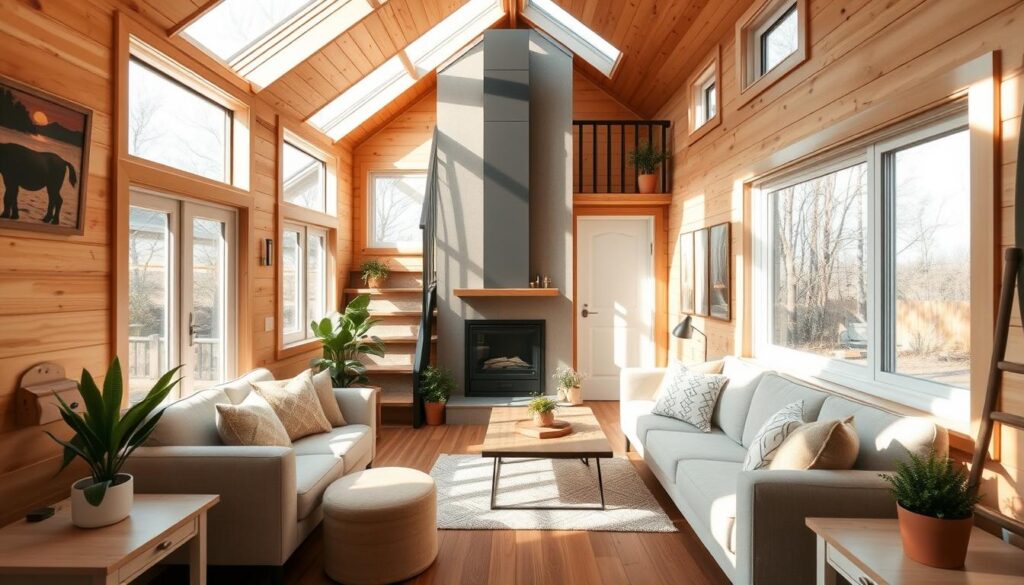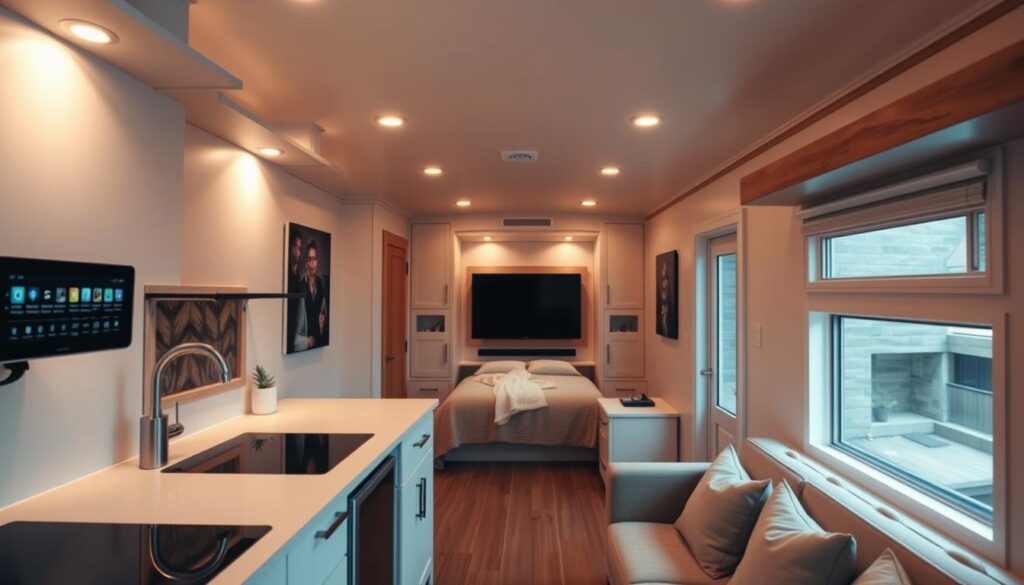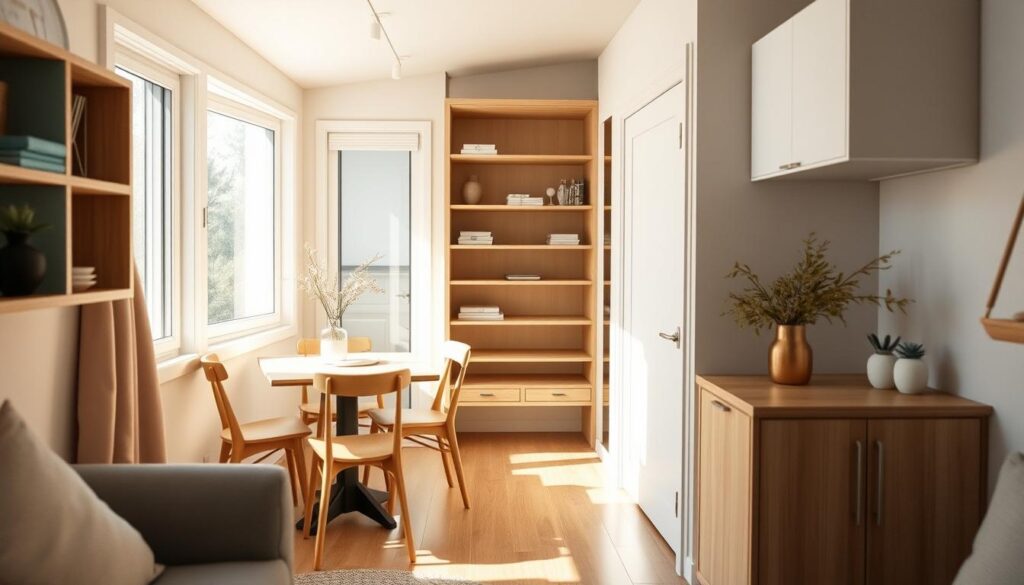Did you know the average American now lives in a much smaller space than a decade ago? This change has led to a creative explosion in small space design. The focus is now on creating tiny home interiors that are both useful and luxurious.
We’ll dive into the main ideas for making small spaces feel big and efficient. We’ll mix creativity with practicality. By using space wisely, picking the right materials, and adding luxury touches, you can make a small space look big and stylish.
Key Takeaways
- Maximizing space in small homes
- Choosing the right materials for tiny home design
- Incorporating luxury elements in compact living
- Practical tips for creating a functional space
- Idea to make your tiny home feel expansive
Understanding the Basics of Tiny Home Design
Designing a tiny home means knowing the basics. This includes how to use space well and add decor. It’s all about making these homes both functional and beautiful.
The Importance of Space Optimization
Space optimization is key in tiny home design. It’s about using every inch of space to make a cozy home. This is done with multi-functional furniture and layouts that are easy to move around in.
It also means keeping things tidy. Each item in the home should have a purpose. This way, even small homes can feel big.
Key Differences Between Tiny and Traditional Homes
Tiny homes are different from regular homes in design and function. They focus on minimalist living, which means owning fewer things and living greener.
They also have open layouts and smart storage to save space. Knowing these differences helps design a tiny home that fits its residents’ needs.
Common Design Mistakes to Avoid
When designing a tiny home, some mistakes to avoid include too many decorations. This can make the space feel cramped. Also, not thinking about how people will move around is a big error.
Not using storage well is another mistake. Adding built-in shelving and cabinets helps keep things organized. This makes the home feel more relaxed and peaceful.
Choosing the Right Layout for Tiny Homes
Choosing the right layout is crucial for tiny homes. It makes the space comfortable and functional. We must consider several factors to make our tiny home livable and efficient.
One key decision is whether to have an open-concept layout or defined spaces. Open-concept living makes a tiny home feel bigger by removing walls. But, defined spaces offer needed separation, like between the bedroom and living room.
Open-Concept vs. Defined Spaces
Open-concept layouts are popular in tiny homes. They create a sense of openness and flow. This makes the space feel airy.
On the other hand, defined spaces are good for different activities. They can be created with room dividers, curtains, or sliding panels. This gives us flexibility in how we use the space.
Multi-Functional Rooms and Furniture
Using multi-functional rooms and furniture is another key strategy. This approach reduces clutter and maximizes space. For example, a sofa bed can be both a seating area and a guest bed.
| Multi-Functional Element | Primary Function | Secondary Function |
|---|---|---|
| Sofa Bed | Seating | Guest Bed |
| Storage Ottoman | Seating | Storage |
| Drop-Down Table | Dining | Work Surface |
The Impact of Flow on Living Experience
The flow of a tiny home is how easily we move through it. Good flow makes a tiny home feel spacious and comfortable. We should plan the layout to ensure a clear path.
By planning carefully and using space-saving solutions, we can make a tiny home functional and comfortable. Whether we choose an open-concept layout or defined spaces, the goal is to use space well and enhance the living experience.
Color Schemes and Material Selection
Choosing the right colors and materials is key in micro home design. It makes the space cozy and functional. It’s important to think about how each part works together for a welcoming feel.
Light Colors to Enhance Space
Light colors on walls and ceilings make a room look bigger. White, beige, and light gray are favorites because they reflect light and open up the space.
Natural Materials for Warmth
Using natural materials like wood, bamboo, and stone adds warmth. These materials make the tiny home feel cozy and connect us to nature.
Sustainable Choices in Finishing
Choosing sustainable finishes is good for the planet and looks great. Reclaimed wood, recycled metal, and eco-friendly paints are smart choices for those who care about the environment.
| Material | Sustainability | Aesthetic Appeal |
|---|---|---|
| Reclaimed Wood | High | High |
| Recycled Metal | High | Medium |
| Eco-Friendly Paints | High | Medium |
| Bamboo | High | High |
By picking the right colors and materials, tiny homes can feel big, cozy, and green. It’s about finding the perfect mix of looks and use.
Maximizing Natural Light in Tiny Interiors
Natural light makes tiny interiors feel bigger and more welcoming. We can use design elements to bring in more light. This makes our tiny homes feel more open and inviting.
Strategic Window Placement
Where we place windows is key in tiny home design. Windows in sunny spots brighten up the inside. Think about using larger windows or skylights for more light.
- Position windows to catch morning and afternoon sun.
- Choose windows with thin frames for more light.
- Think about solar tubes or skylights for extra light.
The Role of Mirrors and Reflective Surfaces
Mirrors and shiny surfaces help spread light around tiny interiors. They reflect light, making the space brighter. Placing mirrors opposite windows bounces light deeper into the home.
- Put mirrors where they can reflect light.
- Use shiny finishes or glass for more reflection.
- Don’t overdo it with too many shiny things to avoid a messy look.

Innovative Lighting Solutions
We can also use new lighting ideas to brighten up our tiny homes. LED lighting and smart lighting systems can mimic natural light. This adds to the brightness and feel of our homes.
- Install LED strips under furniture or in corners for a cozy glow.
- Use smart bulbs that change color to mimic daylight.
- Layer lighting for a more lively and welcoming space.
By using these ideas, we can make our tiny home interiors bright, airy, and welcoming. We make the most of the natural light available.
Creative Storage Solutions for Tiny Homes
Tiny homes need smart storage to make the most of their space. Good storage keeps your home tidy and peaceful.
Built-In Shelving and Cabinets
Built-in shelving and cabinets are key for tiny homes. They offer a neat and tailored storage solution. This way, you can keep things organized and your home looking simple.
Benefits of Built-In Storage:
- Customizable to fit unique spaces
- Enhances the overall design of the home
- Provides ample storage without cluttering the living space
Utilizing Vertical Space
Using vertical space is a smart way to store more in tiny homes. Shelves, storage units, or hanging systems that go up to the ceiling add lots of storage. This doesn’t take up floor space.
Tips for Utilizing Vertical Space:
- Install tall shelving units or bookcases
- Use wall-mounted storage bins or baskets
- Incorporate hanging organizers for clothing or accessories
Under-Bed Storage Options
Under-bed storage is a smart choice for tiny homes, mainly in bedrooms. It keeps your room neat by storing things like out-of-season clothes or bedding.
| Storage Solution | Description | Benefits |
|---|---|---|
| Built-In Shelving | Custom shelves integrated into the home’s design | Space-saving, customizable, aesthetically pleasing |
| Vertical Storage | Shelves or units that extend up to the ceiling | Maximizes vertical space, increases storage capacity |
| Under-Bed Storage | Containers or drawers stored under the bed | Utilizes wasted space, keeps bedrooms tidy |
By using these creative storage ideas, tiny home dwellers can live in a more organized and peaceful space. Whether you’re building a new tiny home or improving an old one, these tips help you use your space wisely.
Furnishing Tiny Interiors Efficiently
Furnishing a tiny home requires choosing furniture that is both scalable and comfortable. We must find space-saving solutions that don’t sacrifice comfort or style. This is crucial for tiny home living.
Selecting Scalable Furniture
Scalable furniture adapts to different spaces and needs. For tiny homes, it means picking pieces that can change size or layout. Modular sofas or nesting tables are great for small spaces because they offer flexibility.
The Benefits of Modular Pieces
Modular furniture is perfect for tiny homes. It lets you customize your space, use it efficiently, and change it up whenever you want. You can mix and match pieces for a functional living area.
| Modular Piece | Benefits | Example |
|---|---|---|
| Storage Units | Efficient use of space, customizable | Stackable drawers or shelves |
| Modular Sofas | Flexible seating, adaptable to different layouts | Sectional sofas with removable components |
| Nesting Tables | Space-saving, versatile | Tables that nest inside one another |
Designing for Comfort in Small Spaces
Comfort is key in tiny home design. We aim to create cozy, inviting spaces. This involves using plush textiles, warm lighting, and chosen color schemes to add warmth and comfort.
By using compact living ideas and focusing on tiny home residents’ needs, we can make interiors that are both functional and cozy.
Personalizing Tiny Home Decor
Making our tiny home feel like our own is key. It’s about creating a space that shows who we are and works well for us.
Emphasizing Personal Style
To make our tiny home unique, we choose items that show our style. This means:
- Picking furniture that’s both useful and meaningful to us.
- Adding textiles like throw blankets and rugs in our favorite colors and patterns.
- Displaying personal items like art, collectibles, or family treasures that share our story.
This way, our home becomes a cozy, welcoming space that truly reflects us.
Wall Art and Decor that Enhance Space
Wall art and decor are crucial for our tiny home’s look. Here are some tips:
- Choose artwork that we love and that shows our interests or values.
- Use mirrors to make rooms look bigger and add depth.
- Add decorative shelves or ledges to display special items, keeping things tidy.
Nature-Inspired Elements
Bringing nature inside is a great way to personalize our tiny home. We can use:
- Plants and greenery to clean the air and add beauty.
- Natural materials like wood, stone, or bamboo in our furniture or decor.
- Earth-toned colors to create a warm, cozy feel.
These elements help us create a cozy, welcoming micro home that feels connected to nature.
Integrating Technology in Tiny Home Designs
Technology is changing how we live in tiny homes, making them more efficient and green. It’s key to making our tiny homes better places to live.
Smart home devices are a big part of this change. They let us control things like lights and temperature easily.
Smart Home Devices for Compact Living
Smart home devices make life easier, and they’re perfect for tiny homes. You can control things like thermostats and lights from anywhere.
- Smart thermostats learn your preferences and save energy.
- Smart lights turn on and off when you want, saving energy and keeping you safe.
- Security cameras let you see what’s happening at home, even when you’re not there.

Energy Efficiency and Sustainability
Technology helps tiny homes use less energy and be more eco-friendly. Using solar panels and energy-saving appliances cuts down on carbon emissions.
Here are some ways to save energy:
- Install solar panels to make your own electricity.
- Choose appliances and lights that use less power.
- Use smart systems to track and manage your energy use.
Staying Connected in Small Spaces
Staying in touch is important, even in tiny homes. Technology offers many ways to stay connected, like fast internet and smart devices.
Here are some ways to stay connected:
- Get a reliable internet service.
- Use apps to control your smart home devices.
- Try voice assistants like Alexa or Google Home to control your home.
By using technology, we can make tiny homes efficient, connected, and eco-friendly.
Outdoor Spaces and Tiny Home Living
Outdoor spaces are key in tiny home living. They help make our homes feel bigger and more connected. By moving our living area outside, we get a more spacious and connected lifestyle.
Creating Functional Patios and Decks
A good patio or deck can make a tiny home feel bigger. Choose durable, easy-to-care-for materials like composite decking or hardwood. This makes your outdoor space last longer with less work.
Think about adding multi-functional elements like built-in seating or storage. This saves space and makes your outdoor area more useful.
Landscaping that Complements Tiny Homes
Landscaping around a tiny home should match its style and the local environment. Use plants native to your area for less upkeep and watering. This keeps your home looking good without a lot of work.
Adding natural elements like stone or wood to your landscaping boosts your home’s look. It makes your home blend smoothly with nature.
The Benefits of Outdoor Living Areas
Outdoor living areas bring many perks to tiny home dwellers. They offer more space for chilling out, having fun, and even growing plants. Using outdoor spaces well can improve our lives a lot.
Plus, outdoor areas help us feel closer to nature. This is really important in small living spaces. It makes our lives more balanced and fulfilling.
Future Trends in Tiny Home Interiors
The tiny home movement is growing, bringing new trends and ideas. We’re moving towards cozy, inviting spaces. These spaces show off our style and care for the planet and community.
Embracing Minimalism
Minimalism is big in tiny home decor, focusing on simplicity and use. It helps make our tiny homes calm and peaceful.
Innovative Eco-Friendly Solutions
Green innovations are popular in tiny home design. We’re using energy-saving gadgets and eco-friendly materials. These choices are good for the planet and make our homes cozy and useful.
For more tiny home design ideas, check out House Beautiful’s tiny house tour. It shows off cool, cozy designs.
Community-Driven Living
Living in community and sharing spaces is becoming more common. It builds connections among tiny home dwellers. By adding these ideas to our designs, we make homes that are beautiful, useful, and connected.


